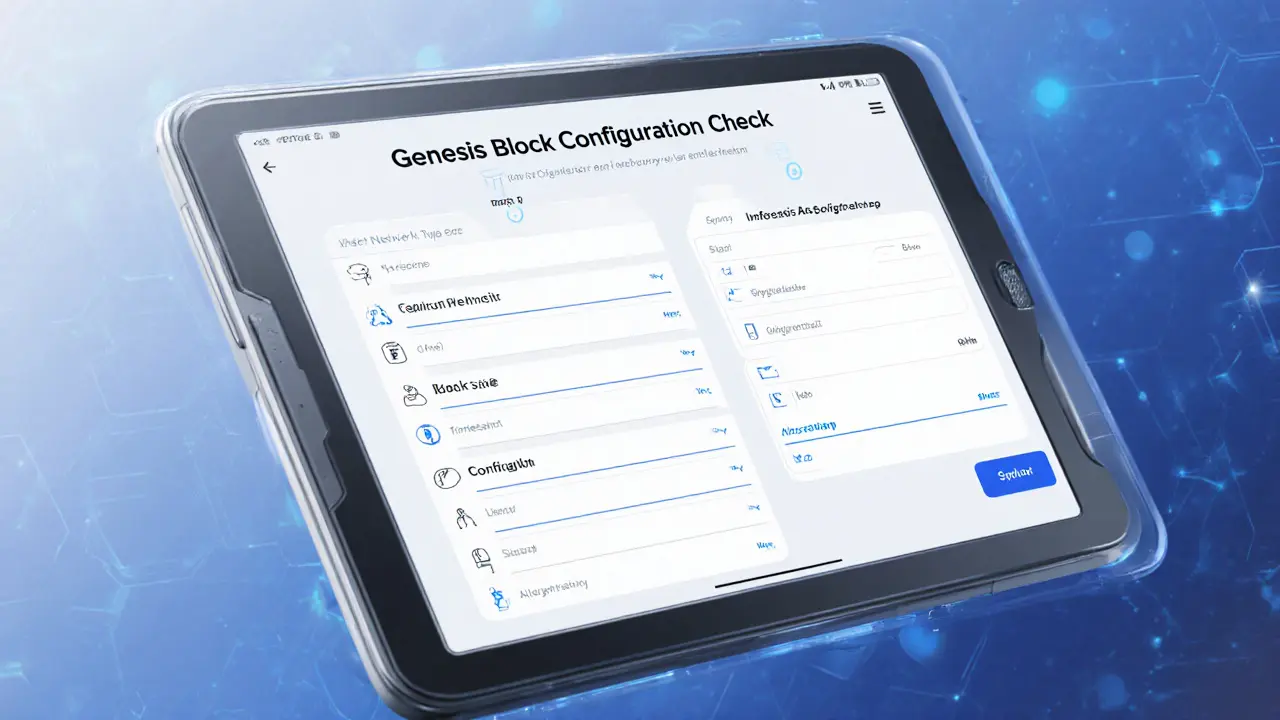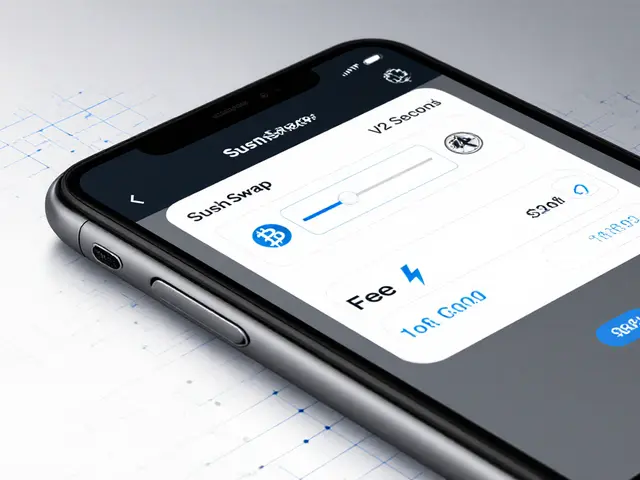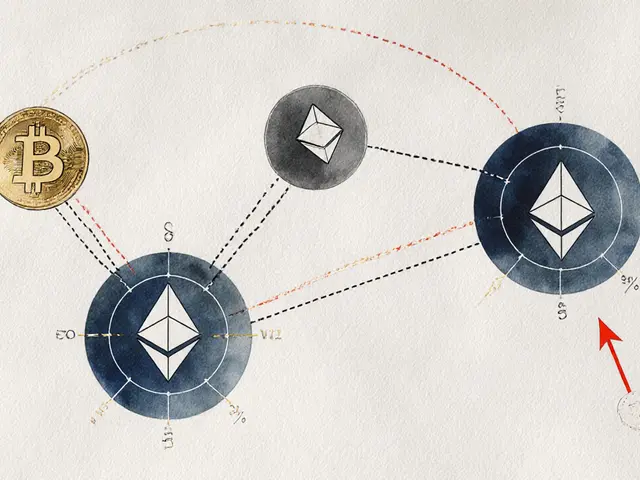Genesis Block Configuration Checker
Network Type
Chain ID
Consensus Mechanism
Block Size Limit (bytes)
Initial Difficulty
Timestamp (Unix Epoch)
Initial Token Allocation
Validation Results
Genesis Block Comparison
| Parameter | Bitcoin | Ethereum |
|---|---|---|
| Configuration Format | C++ source constants | JSON file |
| Network ID / Chain ID | 0 (mainnet) | 1337 (example testnet) |
| Consensus Mechanism | Proof of Work (SHA-256) | Proof of Work (Ethash) - migrating to PoS |
| Block Size Limit | Default 1 MB; configurable | Gas-based limit |
| Initial Difficulty | 0x1d00ffff | 0x20000 |
| Timestamp | 2009-01-03 18:15:05 UTC | 0 (set by node at launch) |
| Initial Allocation | 50 BTC to Satoshi’s address | Custom balances defined in alloc |
When launching a new blockchain, Genesis Block is the first block that sets the network’s initial state and parameters. It acts as a blueprint that every node follows, so getting the configuration right is crucial for security, performance, and future upgrades.
What the Genesis Block Actually Is
The Genesis Block is not just an empty placeholder; it contains a header, a coin‑base transaction, and a set of configuration values that define the entire blockchain’s rules. Because there is no previous block, the "previous block hash" field is hard‑coded to all zeros. All subsequent blocks reference this hash, making it the immutable anchor for the chain.
Core Parameters You Must Define
Before a node can start syncing, the genesis file must describe several mandatory fields. Below is a quick rundown of the most common ones across public networks.
- Network ID / Chain ID: Distinguishes your blockchain from others; prevents accidental cross‑connection.
- Consensus Mechanism: Proof of Work (PoW), Proof of Stake (PoS), Delegated PoS, or hybrid models. This decides how blocks are validated.
- Block Size Limit: Maximum bytes per block. Bitcoin SV, for example, lets admins set this with the
excessiveblocksizeoption. - Gas Limit (Ethereum‑style networks): Upper bound for computational effort a block can consume.
- Difficulty Target: Determines how hard it is to mine the first block. In PoW networks this is a numeric value that the hash must be below.
- Timestamp: Unix epoch time marking when the network officially started.
- Nonce: Used in PoW to satisfy the difficulty condition; often set to a known constant in the genesis.
- Initial Token Allocation: The
allocorbalancessection that seeds accounts with coins or tokens. - Block Reward Schedule: How many new tokens are minted per block, and when rewards halve or change.
- Embedded Message: Optional human‑readable note that becomes permanent on the chain (Bitcoin’s famous newspaper headline).
Bitcoin’s Genesis Configuration
Bitcoin’s first block is a classic example. Its header fields are hard‑coded in the source code and look like this (hexadecimal values):
Version: 01000000 Previous Block Hash: 0000000000000000000000000000000000000000000000000000000000000000 Merkle Root: 3BA3EDFD7A7B12B27AC72C3E67768F617FC81BC3888A51323A9FB8AA4B1E5E4A Timestamp: 29AB5F49 (2009‑01‑03 18:15:05 UTC) Bits: FFFF001D Nonce: 1DAC2B7C
The Bitcoin genesis file also defines the maximum block size via the excessiveblocksize parameter. Administrators can set it in three ways:
- Command‑line flag
-excessiveblocksize=<bytes> - Configuration file entry
excessiveblocksize=<bytes> - Runtime command
bitcoin-cli setexcessiveblock <bytes>(note: not persisted after restart)
Another mandatory consensus setting in newer Bitcoin SV upgrades is the script memory limit, which miners must agree on to avoid fragmentation. The values are typically taken from the largest‑known miner configurations and set higher than the default to future‑proof the network.
Ethereum‑Style Genesis JSON
Ethereum and most EVM‑compatible chains use a genesis.json file. The file has two main sections: config (protocol rules) and alloc (initial balances).
{
"config": {
"chainId": 1337,
"homesteadBlock": 0,
"eip155Block": 0,
"eip158Block": 0,
"byzantiumBlock": 0
},
"difficulty": "0x20000",
"gasLimit": "0x8000000",
"timestamp": "0x00",
"alloc": {
"0xaaaaaaaaaaaaaaaaaaaaaaaaaaaaaaaaaaaaaaaa": { "balance": "0x3635C9ADC5DEA00000" }
}
}
Key points for the Ethereum genesis:
- chainId uniquely identifies the network (1337 is a common testnet ID).
- difficulty starts low to let the first few blocks be mined quickly.
- gasLimit sets the maximum gas per block; higher limits allow more complex contracts early on.
- alloc seeds accounts with ether, often used for development or pre‑mined distribution.

Side‑by‑Side Comparison: Bitcoin vs Ethereum Genesis Settings
| Parameter | Bitcoin | Ethereum |
|---|---|---|
| Configuration Format | C++ source constants (hard‑coded) | JSON file (genesis.json) |
| Network ID / Chain ID | 0 (mainnet) | 1337 (example testnet) |
| Consensus Mechanism | Proof of Work (SHA‑256) | Proof of Work (Ethash) - migrating to PoS |
| Block Size Limit | Default 1MB; configurable via excessiveblocksize |
Gas‑based limit (e.g., 8million gas) |
| Initial Difficulty | 0x1d00ffff (high for early mining) | 0x20000 (low for quick start) |
| Timestamp | 2009‑01‑03 18:15:05 UTC | 0 (set by node at launch) |
| Initial Allocation | 50BTC to Satoshi’s address (unspendable) | Custom balances defined in alloc |
| Embedded Message | "The Times 03/Jan/2009…" | None by default (optional field) |
Best Practices for Setting Up a Genesis Block
Whether you’re forking Bitcoin, launching a private Ethereum network, or building a brand‑new protocol, follow these steps to avoid costly re‑configurations later.
- Document Every Parameter: Keep a version‑controlled
README.mdthat explains why each value was chosen (e.g., block size based on expected TPS). - Use a Testnet First: Deploy the genesis file on a local or cloud‑based testnet. Verify that nodes sync, that the first blocks are accepted, and that token allocations are reachable.
- Lock Down the File: Store the genesis JSON in a read‑only location and enforce OS‑level permissions. Any change after launch will cause a chain split.
- Automate Deployment: Scripts (bash, Ansible, Docker) should pull the exact genesis file and start the node with a single command. This removes human error.
- Plan for Future Upgrades: Include a
forkIdor upgrade flag in the config so you can trigger soft forks without rebuilding the genesis. - Audit Security: Run a checksum (SHA‑256) on the genesis file and compare it across all nodes before they join the network.
Common Pitfalls and How to Fix Them
Even experienced developers trip over a few traps.
- Wrong Chain ID: Nodes will reject connections if they see a mismatched ID. Fix by editing the
chainIdfield and redeploying every node. - Unrealistic Block Size: Setting a massive limit without enough bandwidth leads to network congestion. Reduce the size or provision higher‑capacity links.
- Missing Genesis Hash in Peers: Some clients require the hash to be passed as a startup argument (
--genesis-hash). Provide the correct hash derived from the header. - Invalid Allocation Addresses: Hex strings must be 40 characters (20 bytes) for EVM addresses; otherwise the node will refuse to start. Double‑check address formats.
- Difficulty Too High: If the initial difficulty is set as if the network already has massive hash power, the first block may never be mined. Lower it for test environments.
Next Steps After a Successful Launch
Once the genesis block is live and nodes are syncing, monitor these metrics for at least the first 24‑48 hours:
- Block propagation time (aim for < 2seconds on a well‑connected network).
- Node count and version distribution.
- Gas usage per block (Ethereum) or average transaction size (Bitcoin).
If any metric looks off, pause new node onboarding, adjust the offending parameter in a controlled upgrade, and redeploy the changes across the network.
Frequently Asked Questions
Do I really need a custom genesis block for a private blockchain?
Yes. The genesis file defines the network ID, consensus rules, and initial token balances. Without it, each node would start with its own default parameters, resulting in a split network.
Can I change the block size after the network is live?
Only through a coordinated hard fork. All nodes must agree on the new limit, otherwise the chain will diverge.
What’s the difference between network ID and chain ID?
Network ID is used by the peer‑discovery layer to avoid connecting to the wrong network. Chain ID is part of transaction signatures to prevent replay attacks across forks.
How can I embed a message in my genesis block?
Put the text into the coin‑base script of the first transaction. In Bitcoin it’s stored as an OP_RETURN‑style script; in Ethereum you can add a dummy contract creation transaction that includes the string.
Is it safe to store the genesis file on a public repository?
The file itself is not secret, but you should protect any private keys or pre‑mined allocations it contains. Use environment variables or encrypted vaults for sensitive data.






Anne Zaya
4 January, 2025 . 19:36 PM
Set the chain ID early to avoid cross‑network confusion.
Emma Szabo
4 January, 2025 . 21:16 PM
Choosing a vivid genesis message can double‑tap your community's excitement; think of it as the blockchain's first tweet that future nodes will forever echo. A splash of color in the coin‑base script not only commemorates the launch but also gives developers a fun Easter egg to chase. Pair that with a clear, documented allocation table and you sidestep many “who‑gets‑what” disputes later on. Remember to keep the difficulty low for the first handful of blocks, otherwise you’ll lock out newcomers who are just testing the net. And if you ever need to tweak the block size, schedule a soft fork well‑in‑advance to keep consensus humming.
Fiona Lam
4 January, 2025 . 22:48 PM
Don’t even think about slapping a 10 GB block limit on launch – the network will choke, peers will bail, and you’ll watch your chain die in seconds. Trim it down, test it, then scale up when the traffic actually arrives.
OLAOLUWAPO SANDA
5 January, 2025 . 00:25 AM
Why bother with fancy config files when a single hard‑coded constant can do the job? Keep it simple, keep it local.
Sumedha Nag
5 January, 2025 . 01:55 AM
That ‘simple constant’ approach works until you need to upgrade, then everyone’s stuck with a legacy blob that no one can change without forking.
Holly Harrar
5 January, 2025 . 03:28 AM
Make sure you version‑control the genesis json; it saves a ton of headache later, especially when teammates forget which chainId you used.
Vijay Kumar
5 January, 2025 . 04:56 AM
Start small, iterate fast – launch a testnet, spin up a few nodes, watch the first blocks roll, then celebrate when the allocations show up in wallets.
Edgardo Rodriguez
5 January, 2025 . 06:31 AM
When you draft the genesis configuration, consider it as the philosophical cornerstone of your entire distributed ledger; every parameter you set will echo through every subsequent block, influencing security, performance, and governance. First, the chain ID must be immutable and globally unique, for without that distinctive numeric signature nodes will inadvertently bridge across unrelated networks, leading to cross‑chain replay attacks and consensus fragmentation. Second, the consensus mechanism-whether PoW, PoS, or a hybrid-determines not only the computational hardness of block creation but also the economic incentives that drive participation; a mis‑aligned reward schedule can cause miner attrition or validator apathy. Third, block size limits should be calibrated against projected transaction throughput; oversized limits invite bandwidth bottlenecks, while undersized caps throttle growth and inflate fees. Fourth, the initial difficulty must be low enough to allow a rapid bootstrapping of the first few blocks, yet high enough to prevent an immediate monopoly by any single entity. Fifth, the timestamp, expressed in Unix epoch, anchors the network's temporal reference, and any drift here can create confusion in time‑locked contracts. Sixth, the nonce, while often a placeholder in the genesis, should be a known constant to simplify verification. Seventh, the initial token allocation-encapsulated in an “alloc” map for EVM chains or a coin‑base transaction for Bitcoin‑style networks-must be audited, ensuring that no hidden supply is introduced later. Eighth, embedding a human‑readable message in the coin‑base script not only provides historical context but also serves as a cultural timestamp, much like Satoshi’s headline. Ninth, define upgrade flags or a fork identifier early, because hard‑fork pathways are far cheaper to orchestrate when the protocol already anticipates versioning. Finally, guard the genesis file with strong OS permissions, checksums, and distributed backups; a single alteration after launch results in a chain split that can fracture the community and dilute value. By treating the genesis block as a living document rather than a static dump, you lay a resilient foundation that can evolve without catastrophic disruption.
mudassir khan
5 January, 2025 . 08:05 AM
While the preceding exposition admirably covers many essentials, it neglects to address the practical ramifications of over‑engineering the genesis schema; such excess complexity invariably introduces latency in node initialization, and the accompanying cryptographic overhead may deter participation from resource‑constrained validators.
Danielle Thompson
5 January, 2025 . 09:35 AM
Nice recap! 👍
Eric Levesque
5 January, 2025 . 11:11 AM
National pride demands that our blockchain reflect indigenous standards, not foreign forks.
alex demaisip
5 January, 2025 . 12:43 PM
From an architectural standpoint, the deployment of a sovereign chain necessitates adherence to established EIP‑1559 fee dynamics, calibrated gas‑price elasticity functions, and a meticulously engineered validator set with quorum thresholds defined via Byzantine Fault Tolerance matrices; overlooking these parameters will inevitably precipitate systemic instability and erode stakeholder confidence.
Elmer Detres
5 January, 2025 . 14:11 PM
While the technical depth is impressive, remember to keep the community emotionally engaged; a balanced approach that marries rigorous design with accessible communication will foster broader adoption.
Tony Young
5 January, 2025 . 15:45 PM
Imagine launching a genesis block that sings like a drumroll, echoing through the network as every validator nods in unison – that’s the drama you want! 🎭
Fiona Padrutt
5 January, 2025 . 17:20 PM
That theatrical flair is great, but if the block size is absurdly large, the whole performance will lag and nobody will clap.
Briana Holtsnider
5 January, 2025 . 18:50 PM
The guide glosses over the darker side of governance – without a clear veto mechanism, power can concentrate in the hands of a few early miners, leading to inevitable oligarchy.
Corrie Moxon
5 January, 2025 . 20:21 PM
Even with that risk, a well‑crafted incentive structure can distribute power more evenly, encouraging decentralization and long‑term network health.
Jeff Carson
5 January, 2025 . 21:58 PM
Curious about how the genesis hash is derived? It’s a simple SHA‑256 of the header fields, then encoded in hex – a quick command line snippet can verify it across all nodes. 😊
Alex Yepes
5 January, 2025 . 23:31 PM
Indeed, the genesis hash calculation follows the standard Merkle‑root construction: concatenate the version, previous block hash (all zeros), Merkle root, timestamp, difficulty bits, and nonce; then apply double SHA‑256. This deterministic process guarantees that any deviation in the genesis configuration yields a distinct hash, thereby preventing accidental chain collisions. Moreover, storing the hash in a read‑only file and distributing it via secure channels ensures that all participants commence from an identical state, a prerequisite for consensus integrity. Finally, automated CI pipelines can embed this verification step, catching mismatches before deployment.